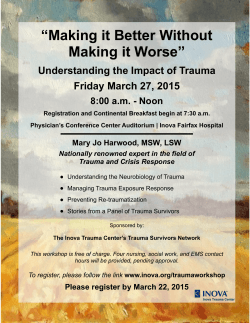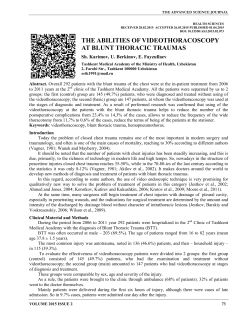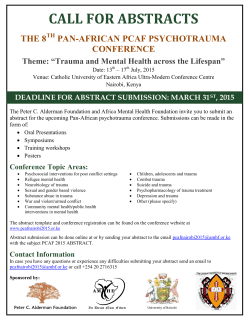
Occult pneumothoraces in ventilated pediatric trauma patients: a
RESEARCH • RECHERCHE Occult pneumothoraces in ventilated pediatric trauma patients: a review Courtney Fulton, MD Ioana Bratu, MD, MSc A portion of this work was presented at the Trauma Association of Canada meeting 2014 (Montréal, Que.) Accepted for publication Nov 11, 2014 Early-released on Apr. 1, 2015; subject to revision Correspondence to: C. Fulton Department of Surgery 2C3.56 WMC 8440–112 St. Edmonton AB T6G 2B7 cfulton@ualberta.ca Background: Currently there is no clinical consensus on how to treat occult pneumothoraces in adults, and even less research has been done in children. We sought to understand the outcomes of severely injured, ventilated children with occult pneumothoraces. Methods: Using the Alberta Trauma Registry, we retrospectively reviewed the charts of all ventilated pediatric patients at a children’s hospital from 2001 to 2011 who had an injury severity score greater than 12 and a diagnosis of occult pneumothorax (seen on computed tomography scan but not on supine chest radiograph). Results: There were 1689 severely injured children, with 496 admitted to the pediatric intensive care unit (PICU) and ventilated. A total of 130 children were found to have pneumothoraces, and of those, 96 were admitted to the PICU. Of those, 15 children had a total of 19 occult pneumothoraces, and all were successfully treated without chest tubes. The average age was 13.4 (range 2.0–17.0) years, and 54% of these children were male. The average time spent on the ventilator was 2.3 (range 0–13) days, and 7 children had at least 1 operation. Conclusion: In our institution, occult pneumothoraces occur in very few severely injured, ventilated pediatric trauma patients. Our study adds to the increasing evidence in the adult and pediatric literature suggesting that occult pneumothoraces may be safely observed even while under positive-pressure ventilation. DOI: 10.1503/cjs.009314 Contexte : À l’heure actuelle, il n’existe pas de consensus clinique sur la façon de traiter le pneumothorax occulte chez les adultes et encore moins de recherches ont porté sur les enfants. Nous avons voulu comprendre comment évoluent les enfants grièvement blessés porteurs d’un pneumothorax occulte placés sous respirateur. Méthodes : À partir du registre de traumatologie de l’Alberta, nous avons analysé de manière rétrospective les dossiers de tous les patients pédiatriques sous respirateur dans un hôpital pour enfants entre 2001 et 2011; ces enfants présentaient un score de gravité des blessures supérieur à 12 et un diagnostic de pneumothorax occulte (révélé par la tomodensitométrie mais non par la radiographie pulmonaire en décubitus dorsal). Résultats : Nous avons dénombré 1689 enfants grièvement blessés, dont 496 ont été admis dans une unité de soins intensifs pédiatriques (USIP) et placés sous respirateur. En tout, 130 enfants présentaient un pneumothorax et 96 d’entre eux ont été admis à l’USIP. Parmi ceux-ci, 15 présentaient en tout 19 pneumothorax occultes, et tous ont été traités avec succès sans drains thoraciques. L’âge moyen était de 13,4 (entre 2,0 et 17,0) ans et 54 % de ces enfants étaient de sexe masculin. La durée moyenne de la ventilation assistée a été de 2,3 (entre 0 et 13) jours et 7 enfants ont dû subir au moins une intervention chirurgicale. Conclusion : Dans notre établissement, le pneumothorax occulte s’observe chez très peu de grands blessés pédiatriques placés sous respirateur. Notre étude vient étayer les preuves présentées dans la littérature sur les adultes et sur les enfants selon lesquelles les patients atteints de pneumothorax occulte peuvent être placés en observation en toute sécurité, même sous ventilation en pression positive. © 2015 8872147 Canada Inc. Can J Surg, 2015 1 RECHERCHE A ny child injured from blunt torso trauma has a 4% chance of having a pneumothorax, with more than half identified as being occult (defined as a pneumothorax observed on computed tomography [CT] scan of the chest or abdomen, but not on chest radiograph).1,2 In adults, pneumothoraces can occur in up to 64% of the most severely injured, ventilated patients.3 Currently there is no clinical consensus on how to treat occult versus overt pneumothoraces in adults, and even less research has been done in children.4 A common clinical concern voiced by those taking care of severely injured children is whether or not the occult pneumothroax can be observed. The worry is progression to life-threatening tension pneumothorax, especially if the child is receiving positive-pressure ventilation. One pediatric study showed that it was safe to observe occult pneumothoraces in children; only 4% progressed to needing a chest tube.5 However, only 20% of their patients were ventilated. A more recent study with a larger population of ventilated children showed a progression rate up to 38%.2 Our objective was to understand how our institution has managed occult pneumothoraces in severely injured children on mechanical ventilation. Methods Using the Alberta Trauma Registry, we conducted a retrospective chart review of all patients (0–17 yr) admitted to the Stollery Children’s Hospital and the pediatric intensive care unit (PICU) between January 2001 and December 2011. Included patients were mechanically ventilated, had an injury severity score (ISS) greater than 12 and a diagnosis of pneumothorax (ICD code 860). There is no separate ICD code for occult pneumothorax, so the presence of occult pneumothorax had to be determined with thorough chart review. We excluded patients from the study when chart review revealed that neither a pneumo- or hemothorax was diagnosed. All eligible charts were reviewed for demographic characteristics, injury specifics, timeline of injury, diagnosis of pneumothorax, placement of chest tube(s), progression of pneumothorax and complications. Once we identified children with occult pneumothoraces, we calculated the size of the pneumothorax by measuring the largest collection of air in a line perpendicular to the chest wall on the CT scan of the chest or abdomen (as described by Notrica and colleagues5). Patients were followed until hospital discharge. Statistical analysis 496 of these children were admitted to the PICU and received mechanical ventilation. Overt pneumothoraces occurred in 130 of the 1689 (7%) patients and in 89 of the 496 (18%) ventilated patients in the PICU. Of the severely injured children (ISS > 12) with blunt trauma and ventilated in the PICU, 15 children received a diagnosis of occult pneumothorax, and 74 received diagnoses of pneumothorax other than occult pneumothorax. Occult pneumothorax A total of 19 occult pneumothoraces were identified in 15 children. The mean age of patients with occult pneumothoraces was 13.4 (median 15.1, range 2–17) years. Approximately half were boys. The average Glasgow Coma Scale (GCS) score was 10.2 (median 14). The average ISS was 34.9 (range 16–66; Table 1). None of these children died from their injuries. All of them had blunt trauma: 8 children were involved in motor vehicle collisions, 3 were pedestrians struck by cars, 2 were in all-terrain vehicle accidents, 1 was involved in a cycling accident, and 1 was struck by an object. Nine children were transported from other hospitals; many travelled for hours before reaching the trauma centre. Five children had right-sided injuries, 6 had left-sided injuries and 4 had bilateral injuries. All of these were successfully managed without chest tubes. Six patients had zero ventilator days, which means they were intubated for less than 24 hours. One child was reintubated for an operation later on in the hospital stay. Four children were intubated at outside institutions, likely owing to long transport times. On average, children were ventilated for 2.3 (range 0–13) days, spent 4.4 (range 1–14) days in the PICU and were discharged from hospital after 17.8 (range 3–79) days. Seven children had at least 1 operation, and 1 child had 5 operations without progression of the pneumothorax. None of the operations were in the chest; operations included laparotomies, orthopedic procedures, craniotomies, Table 1. Demographic and clinical characteristics of 15 children with occult pneumothoraces Characteristic Age, yr Mean (range)* 13.4 (2–17) Male sex, % 54.4 Blunt trauma, % 100.0 Transferred from outside hospital, % 60.0 We analyzed the data using the Microsoft Excel statistical package version 2013. GCS 10.2 (3–15) Ventilator days 2.3 (0–13) PICU stay, d 4.4 (1–14) Results Hospital LOS, d 17.8 (3–79) ISS 34.9 (16–66) During the 10-year study period, 1689 patients were admitted to hospital for traumatic injuries (ISS > 12), and GCS = Glasgow Coma Scale; ISS = injury severity score; LOS = length of stay; PICU = pediatric intensive care unit. *Unless otherwise indicated. 2 J can chir, 2015 RESEARCH spinal procedures and wound débridement. In terms of complications, 1 child had bilateral aspiration pneumonia and another had ventilator-associated pneumonia. While occult pneumothorax was diagnosed on CT scan in all 15 children, 3 of them had their occult pneumothoraces detected on CT scan of the abdomen alone and did not undergo CT of the chest even after pneumothorax was diagnosed. Interestingly, these 3 children had the largest measured pneumothoraces at 14.1, 14.6 and 17.5 mm, respectively. The average size of occult pneumothorax was 8.4 mm (range 3–17.4; Fig. 1). Overt pneumo- or hemothorax A total of 106 pneumo- or hemothoraces were identified in 74 children. Most of these patients received a chest tube as soon as the diagnosis was made (either clinically or radiologically). Forty-eight of 74 children (65%) had at least 1 chest tube placed at our institution, while only 26 (35%) had 1 or more tubes placed outside the trauma centre. The vast majority of chest tube insertions were uncomplicated, with most issues being proper tube placement and depth. Fourteen children with 16 small (nonoccult) pneumothor aces were initially treated without a chest tube. Five of these children had radiologic and/or clinical progression while on mechanical ventilation, requiring a chest tube. Thirty-nine children had a single sided chest tube; this number includes the 5 children who progressed. Twentysix children had bilateral chest tubes. Twenty-two children experienced complications related to the chest tubes, with 1 child having bilateral complications. Incorrect tube placement occurred in 16 children, 10 of whom needed adjustments. Twelve children needed at least 1 more chest tube. Six patients who experienced complications had their tubes placed at an outside hospital. Discussion The clinical dilemma of how to manage occult pneumothorax in a severely injured child who is ventilated is more prevalent as “pan scans” of the head, spine, chest, abdomen and pelvis are more common in the management of pediatric trauma than they were 10 years ago.6 This inevitably leads to the diagnosis of more occult pneumothor aces. The study by Notrica and colleagues5 reports that all occult pneumothoraces under 16.5 mm were successfully managed without a tube thoracostomy. We obtained similar results in our study, and our other results suggest that even small nonoccult pneumothoraces can be managed without intervention 69% (11/16) of the time. While there are no established protocols for monitoring occult pneumothoraces in our institution, all intubated patients undergo daily chest radiography and are closely monitored one on one, allowing changes in clinical status to be identified quickly. Limitations While our sample may have been small, to our knowledge this is the first Canadian review of pediatric occult pneumothoraces, and we included more ventilated patients than Notrica and colleagues.5 Any retrospective review such as ours has inherent limitations based on the chart material available for study. Trauma reporting has become more standardized in the last 10 years, but many children in our study came from outside institutions and 3.5 3 Frequency 2.5 2 1.5 1 0.5 0 0 1 2 3 4 5 6 7 8 9 10 11 12 13 14 15 16 17 18 19 20 Size of pneumothorax (mm) Fig. 1. Frequency of occult pneumothoraces based on size (mm). Can J Surg, 2015 3 RECHERCHE their charts were missing many prehospital records. Some small pneumothoraces may also have been excluded from our study if it was unclear from the chart whether the pneumothorax was visible on the first chest radiograph. The lack of clarity was most frequently due to a lack of access to original chest radiographs from other centres or to the original radiographs never having been officially reported. Similar diagnostic problems occur in adults, depending on whether the trauma team or a radiologist diagnoses pneumothoraces on the chest radiograph.7 A recent meta-analysis of the role of observation for occult pneumothoraces indicates that it is likely safe to observe this type of injury, but there is not enough evidence in patients receiving positive-pressure ventilation.8 Currently a large randomized controlled trial is underway in adults that will hopefully answer this question.9 Interim results show that it is safe to observe occult pneumothor aces in adults receiving positive-pressure ventilation, but any patient being ventilated for longer than 1 week is more likely to progress and may need pleural drainage.9 This risk must be balanced against a 15% tube thoracostomy complication rate.9 The largest prospective trial on occult pneumothoraces in children after blunt trauma was recently conducted by Lee and colleagues.2 Out of 224 children with occult pneumothoraces (4.7% incidence rate), only 35 (16%) needed chest tubes. However, all of the children who required tube thoracostomy were either intubated in the PICU (17 of 45) or intubated for an operation (19 of 80).2 Owing to the large number of centres involved in the study, there was considerable variety in the percentage of intubated patients who received tube thoracostomies (6%–49%). The authors acknowledge that this variability indicates that management of tube thoracostomies should be standardized across institutions. The reported variability of some centres being more aggressive at chest tube insertion than others may be a reflection of the anxiety provoked by the diagnosis of occult pneumothoraces and the notion that one must act quickly to prevent a tension pneumothorax. While we should be aware of the potential of progression to tension pneumothorax, our study reinforces that careful, thoughtful awareness of the occult pneumothorax followed with continuous monitoring of the patient’s vital signs and daily chest radiography while the patient is ventilated will mitigate the risk of sudden expansion of the pneumothorax. We chose to limit our study to ventilated pediatric patients with severe blunt trauma, as dictated by our clin ical question. While it is possible for occult pneumothor 4 J can chir, 2015 aces to progress in patients who are not ventilated, it is much less common. The study by Lee and colleagues2 reported no progressions in patients who never received positive-pressure ventilation. We were most interested in our institution’s practice with these and similar patients, as they seem to be a population more vulnerable to progression to clinically important pneumothoraces. Conclusion In our institution, occult pneumothoraces occur in very few severely injured, ventilated pediatric trauma patients. Our study adds to the increasing evidence in the adult and pediatric literature suggesting that occult pneumothoraces may be safely observed, even while patients are receiving positive-pressure ventilation, with continuous monitoring and serial chest radiography. Affiliations: Both authors are from the Division of Pediatric General Surgery, Department of Surgery, University of Alberta, Edmonton, Alta. Competing interests: None declared. Contributors: I. Bratu designed the study. Courtney Fulton acquired the data, which both authors analyzed. Both authors wrote and reviewed the article and approved the final version for publication. References 1. Holmes JF, Brant WE, Bogren HG, et al. Prevalence and importance of pneumothoraces visualized on abdominal computed tomographic scan in children with blunt trauma. J Trauma 2001;50:516-20. 2. Lee LK, Rogers AJ, Ehrlich PF, et al. Occult pneumothoraces in children with blunt torso trauma. Acad Emerg Med 2014;21:440-8. 3. Guerrero-López F, Vazquez-Mata G, Alcazar-Romero PP, et al. Evaluation of the utility of computed tomography in the initial assessment of the critical care patient with chest trauma. Crit Care Med 2000;28:1370-5. 4. Ball CG, Dente CJ, Kirkpatrick AW, et al. Occult pneumothoraces in patients with penetrating trauma: Does mechanism matter? Can J Surg 2010;53:251-5. 5. Notrica DM, Garcia-Filion P, Moore FO, et al. Management of pediatric occult pneumothorax in blunt trauma: a subgroup analysis of the American Association for the Surgery of Trauma multicenter prospective observational study. J Pediatr Surg 2012;47:467-72. 6. Broder J, Fordham LA, Warshauer DM. Increasing utilization of computed tomography in the pediatric emergency department, 20002006. Emerg Radiol 2007;14:227-32. 7. Ball CG, Kirkpatrick AW, Feliciano DV. The occult pneumothorax: What have we learned? Can J Surg 2009;52:E173-179. 8. Yadav K, Jalili M, Zehtabchi S. Management of traumatic occult pneumothorax. Resuscitation 2010;81:1063-8. 9. Kirkpatrick AW, Rizoli S, Ouellet JF, et al. Occult pneumothoraces in critical care: a prospective multicenter randomized controlled trial of pleural drainage for mechanically ventilated trauma patients with occult pneumothoraces. J Trauma Acute Care Surg 2013;74:747-54.
© Copyright 2025









